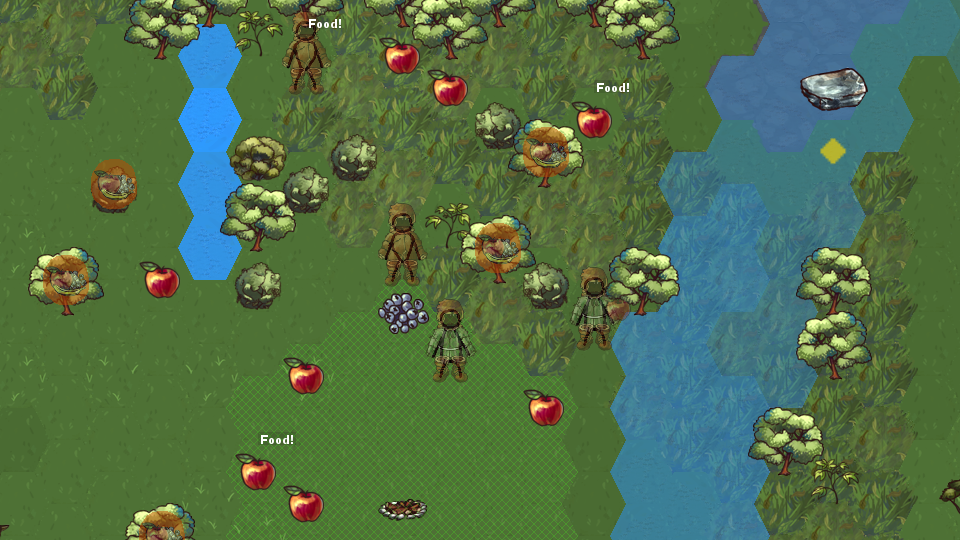Balancing the human artificial intelligence has been one of the harder parts of development. The difficulty stems from trying to make the AI do things that seem “logical” to the player. For example, consider the two possible desirable actions “harvest food” and “eat food”. We need to determine which action takes priority. If someone is hungry, the logical action would be to see if there’s any food around and eat it. OK, simple. We set the desire to eat to be higher than the desire to harvest food.
What if there isn’t anything to eat lying around? Since the desire to eat is higher, they will continually try to eat and never try to harvest food first. The player thinks, “What a stupid AI”. The logical action would be to harvest food first, and then eat the food. OK, then let’s switch it around so we set the person’s desire to harvest food to be higher than the desire to eat food.
Now what if the player creates 50 “harvest food” tasks on 50 different plants? Remember, the tribe member’s desire to harvest food is set higher than their desire to eat food. The AI thought process will be: hungry -> harvest food -> harvest food -> … -> harvest food -> STARVING -> harvest food -> harvest food -> starved to death. They will continue harvesting until they either finish all the harvest tasks or starve to death, despite being surrounded by plenty of recently harvested food. Once again the player thinks, “What a stupid AI”.
One way to work around this is having a variable desire to eat that fluctuates depending on current conditions. Firstly, add a check for food’s existence before trying to eat food. If there is nothing to eat, then set the desire to eat to be zero, no matter how hungry the person. That way the person will carry out any harvest tasks first. Secondly, if something to eat exists, make the person’s desire to eat higher the hungrier they become. With these extra rules, let’s see how the AI behaves in the above scenario with 50 harvest tasks.
The AI thought process will be: hungry -> look for food -> find no food -> harvest food -> harvest food -> … -> harvest food -> STARVING -> look for food -> find food -> eat food. This thought process requires more calculations, but it makes the tribe member appear smarter to the player.
Now add in desires for drinking, sleeping, staying warm, fighting, fleeing, finding missing equipment, crafting and building to this equation. It’s pretty easy to end up with an AI that doesn’t always do the “logical” thing if the desires aren’t carefully balanced. Even worse is an AI whose desire fluctuates every few milliseconds, causing it to flip-flop between two different actions but not making any progress on either one. If you’ve ever seen an AI in a game move their units backward and forward over and over again, you’ll know what I mean.
I’m constantly testing and tweaking the human AI in Tribe Of Pok to balance desires (and stop them burning themselves, like in the above gif). It can be time-consuming, but I think it’s worth the effort. It’s great to see your Pokians on screen running around acting the way you would expect.





I saw your reddit comment about having a passion project that is so complex it has already taken years to implement, got interested and found this blog. You really seem to have deep simulation that many players might not really see or appreciate, but I see that it is important to get right for this kind of game and you personally as well.
I also have a hobby game project that has been going for quite a while, and I notice that my drive to not take the simple and common route on many aspects of simulation have certainly raised the bar on overall difficulty of implementation and amount of hard work required. Maybe we are a bit similar in this aspect.
It can be misleading to the public how these massive modern game engines with nice integrated editors, and asset stores full of professional quality stuff available for a few dollars, enable to create nice-looking but shallow prototypes with little effort, while creating a real game (especially with just a few libraries) takes serious discipline, skill and determination, I just wanted to say that while I don’t really know your game, I respect your work and want to cheer you on to finish and release it one day!
Thanks Metalfusion for your kind words. It is definitely hard to make and balance many different complex systems. One of the things I’ve realised over the years is that the simulation complexity is worth less from a gameplay perspective if I don’t expose elements of it to the player. The player needs to be able to react to the simulation in a meaningful way. I’ve been thinking about that and holding myself back from adding any more complexity until all the current elements have a purpose.
I wish you luck in your own project, and hope to see it out there one day as well!